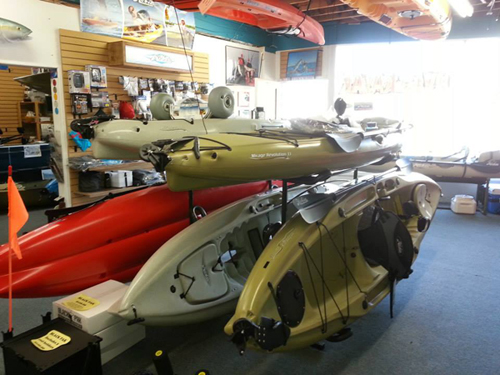Choosing The Right Kayak

So you've decided to give this kayak fishing craze a shot. Your first order of business is breaking the news to the wife. Your second order of business is selecting a kayak. In this article we'll look at part two of your kayak fishing journey. Convincing the wife is up to you...
The first thing you need to do is envision what you want your kayak to be. Do you want a lot of electronics and accessories? Are you more concerned with stability or speed? Is storage or transportation an issue? What's your budget? These are all things to consider before purchasing your first fishing kayak. Oh yeah, and forget about sit-inside kayaks. The sit-on-tops allow easier mounting options, are safer and are generally far superior for fishing.
Fishing Kayaks Keep in mind that just like cars, boats, airplanes, etc. each manufacturer makes their kayaks a little bit differently than the next. One thing you want to make sure of is that whichever kayak you're interested in has been roto-molded. In this process (over-simplified) melted plastic is poured into a hollow mold and then spun around so that the plastic sticks to all sides of the mold and is then removed so that it is all one piece. Some cheaper brands are made by sticking two separate halves together which can result in pinhole leaks and cracks in surprisingly short time.
Once you've determined the quality of the particular brand of interest, check out the overall design of their different models. A longer and narrower kayak will usually be faster but not as stable as a wider boat. This area of kayaks is a trade off. The fastest kayak will not be the most stable, and vice versa. The design of the hull itself can have some influence on this so check out the shape of the hull. A keel design will greatly improve stability while a round bottom has the least resistance and helps speed.
A quick disclaimer on speed and stability before we get too carried away; there are two types of stability: Primary and Secondary. Primary Stability is how stable the kayak feels as you're sitting in it under normal circumstances. So sitting in a chair at the kitchen table should have excellent primary stability given that you feel very stable sitting in that chair. The chair doesn't feel like it's going to tip over at any given moment. Secondary Stability is what it actually takes to tip the kayak over. So if you lean back in that chair far enough you'll get to a point of no return where you're hitting the floor (at the delight of the rest of your family. Particularly your wife if you skipped Step 1 above. That chair would have poor Secondary Stability. Some kayaks feel very stable but get to a point of no return where they're flipping. Others feel not quite as stable but take a lot more to actually flip the thing. Most people prefer high primary stability so that you have a stable platform for fishing from. Often times you can find a kayak with such high primary stability it will be very difficult to even get the point where secondary stability is a concern.
Fishing Kayaks As for speed, we're not talking about winning any races, it's just the amount of effort it takes to move the kayak through the water. A faster kayak is easier to paddle and doesn't result in as much fatigue throughout the day. And a little extra speed can come in handy now and then when you're chasing down birds or you want to get to the spot quickly.
Now think about what accessories you want to add to the kayak. If you want flushmount rodholders make sure there are areas to install them. Have the finished product in your head and make sure all of your plans are feasible with the kayak you intend to purchase. A lot of people skip this step and find out later that there's no room for flushmount rodholders or nowhere to put a bait tank and they end up selling the kayak and starting over, or giving up on the idea altogether.
Different designs will have more flat surfaces than others, which can be very useful for mounting accessories. Keep in mind with a mostly flat sided kayak it's necessary for the manufacturer to use a thicker plastic because just as a circle holds more force than a square, a round sided kayak can use thinner plastic which will influence the overall weight of the kayak.
Advertised specifications are worth noting as well, specifically weight capacity, weight of the kayak and length and width. These will all play a role in your decision. Think about things like storage, transporting, launching, and to a degree the length and width will give you an idea of the overall speed and stability of the kayak, not taking the hull design into consideration. Weight capacity can be a concern for larger paddlers, or smaller paddlers who plan on coming home with a boat full of yellowtail.
Besides these general considerations, there are a number of kayak fishing features specific to various models of kayaks, so shop around and find the features that appeal to you! Hobie makes one of the most popular features, a foot controlled pedal system called the mirage drive, amongst many other fishing friendly accessories and add ons. Give us a call or email and we'd be happy to give a full run down on what makes Hobie Kayaks the best in the kayak fishing business.